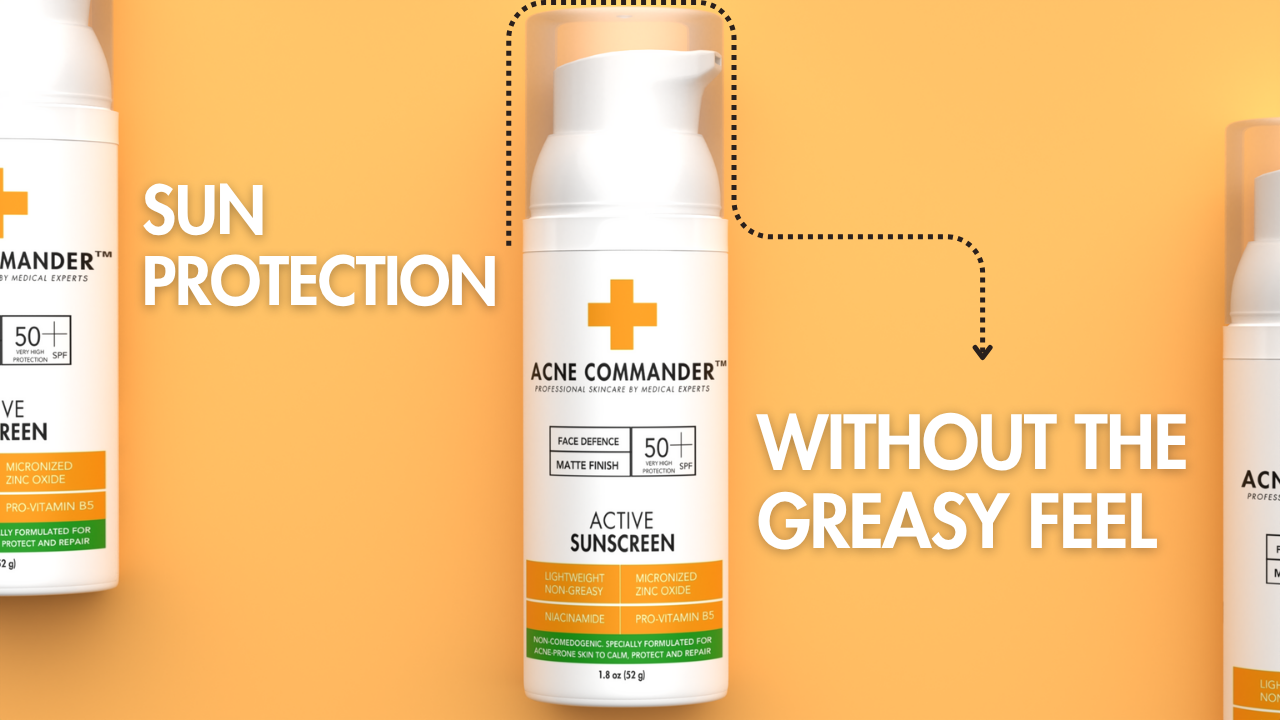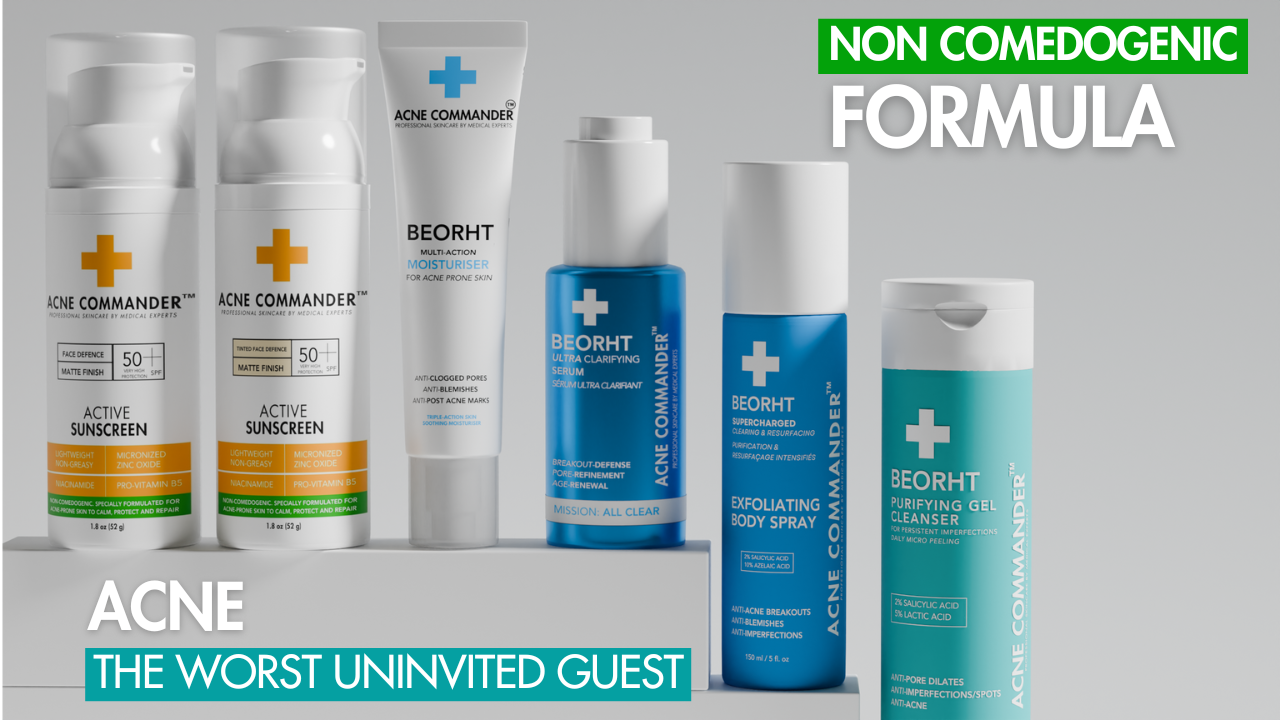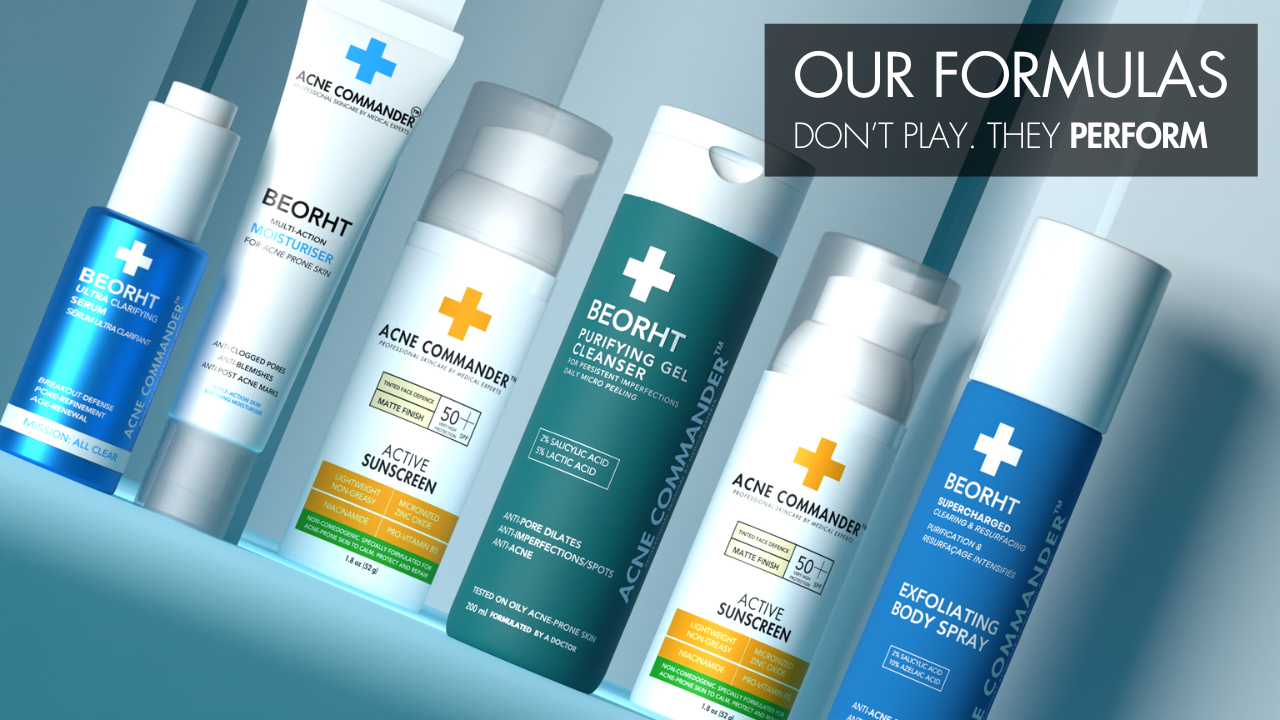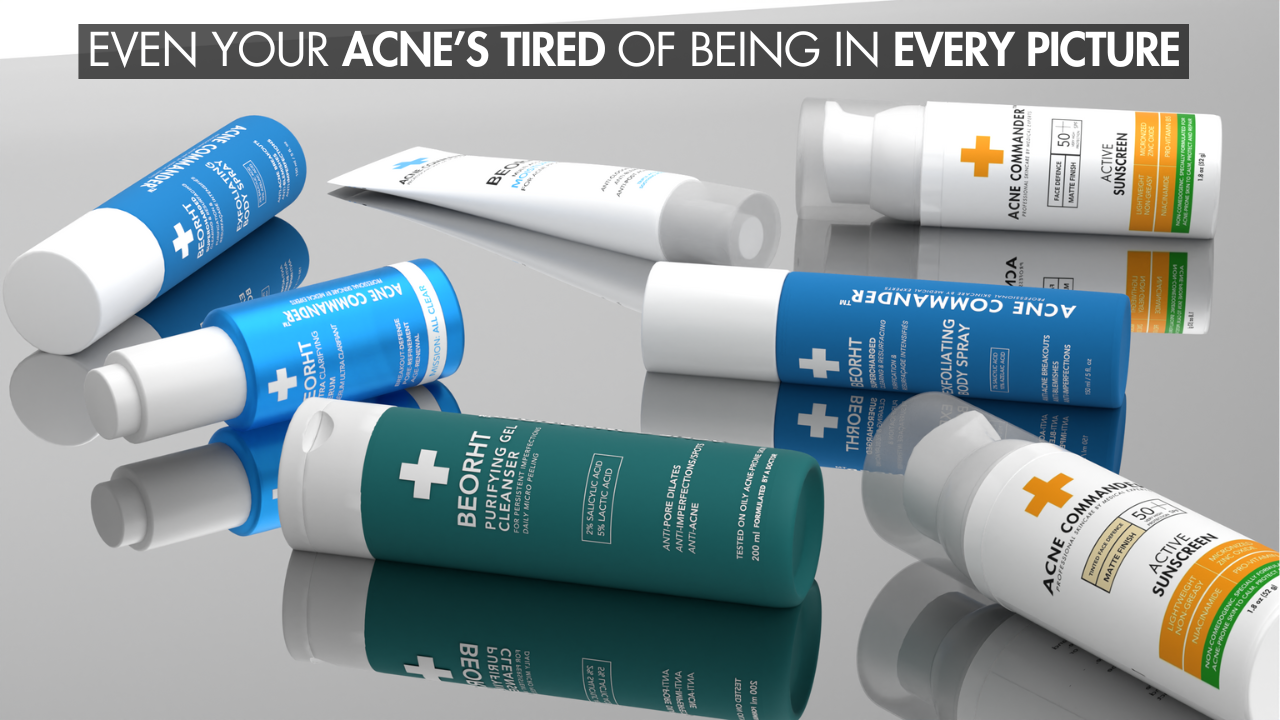Introduction
Acne is one of the most common skin concerns, affecting people of all ages. While there are several factors that contribute to acne, one of the primary causes is clogged pores. Exfoliation plays a critical role in acne prevention by helping to keep the pores clear, remove dead skin cells, and maintain a healthy skin barrier. But what is the role of exfoliation in acne prevention, and how can it help keep your skin smooth and acne-free?
Exfoliating regularly helps to maintain clear, healthy skin by addressing one of the main contributors to acne clogged pores. In this article, we’ll explore how exfoliation works, why it’s essential for acne prevention, and which exfoliation methods are most effective for managing acne. We’ll also highlight Acne Commander’s Beorht Purifying Gel Cleanser, a product designed to gently exfoliate and treat acne-prone skin.
What Is Exfoliation?
Exfoliation is the process of removing dead skin cells from the surface of the skin. The skin naturally sheds dead cells as part of its regeneration process, but sometimes these dead cells can accumulate and clog the pores. When pores become clogged with dead skin cells, sebum (oil), and other debris, they can lead to the formation of blackheads, whiteheads, and more severe forms of acne.
There are two primary types of exfoliation:
1. Physical Exfoliation
Physical exfoliation involves the use of scrubs or tools (such as brushes, sponges, or facial scrubs) to manually remove dead skin cells from the surface of the skin. These exfoliants often contain granules or beads that help slough off the outer layer of skin.
-
Pros: Immediate smoother skin texture, can be satisfying, and often readily available in skincare products.
-
Cons: Can be abrasive, causing irritation, inflammation, or microtears in the skin if used too harshly. Not recommended for sensitive or acne-prone skin.
2. Chemical Exfoliation
Chemical exfoliation uses active ingredients like alpha hydroxy acids (AHAs) or beta hydroxy acids (BHAs) to dissolve dead skin cells and unclog pores. Salicylic Acid (a BHA) and Glycolic Acid (an AHA) are two of the most common chemical exfoliants used in acne treatment.
-
Pros: More controlled exfoliation, deeper penetration into pores, can be gentler on the skin than physical exfoliation.
-
Cons: Can cause irritation if overused, and some chemical exfoliants may make the skin more sensitive to the sun.
How Does Exfoliation Help Prevent Acne?
Exfoliation plays a key role in acne prevention by helping to clear pores and maintain skin health. Here’s how exfoliation helps in the fight against acne:
1. Prevents Clogged Pores
The main cause of acne is clogged pores. When pores become clogged with excess oil, dead skin cells, and other debris, they create an environment for bacteria to thrive. This leads to inflammation, breakouts, and acne.
-
Exfoliation helps by removing dead skin cells from the surface of the skin and inside the pores. By keeping the pores clear, exfoliation prevents blockages that can lead to blackheads, whiteheads, and pimples.
2. Reduces Oil Buildup
Excess oil production, particularly in oily skin, is one of the major contributors to acne. When oil accumulates in the pores and mixes with dead skin cells, it creates a sticky substance that can clog the pores and promote the development of acne.
-
Exfoliation can help regulate oil production by removing oil from the skin’s surface and keeping pores clean. Certain exfoliants, such as Salicylic Acid, work inside the pores to break down excess oil and keep the skin from becoming greasy.
3. Helps Unclog Blackheads and Whiteheads
Blackheads and whiteheads are types of acne that form when the pores become clogged with oil and dead skin cells. In blackheads, the clogged material is exposed to air, causing it to oxidize and turn black. In whiteheads, the pore is closed, trapping the material beneath the skin.
-
Exfoliation helps remove the buildup that causes blackheads and whiteheads, reducing their appearance and preventing new ones from forming. Chemical exfoliants like Salicylic Acid are especially effective for treating these types of acne, as they penetrate deep into the pores and clear out debris.
4. Improves Skin Texture and Reduces Hyperpigmentation
After acne heals, it often leaves behind dark spots or hyperpigmentation. This can make the skin look uneven, with lingering scars or discoloration from previous breakouts.
-
Exfoliation helps to fade hyperpigmentation by removing the outer layer of dead skin cells and promoting the turnover of new, healthier skin cells. Over time, regular exfoliation can help lighten dark spots and improve skin texture, leading to clearer and more even-toned skin.
5. Reduces Inflammation and Promotes Healing
Exfoliating agents like Salicylic Acid have anti-inflammatory properties that help reduce the redness and swelling caused by acne lesions. Exfoliation helps calm the skin, making acne less noticeable and encouraging faster healing.
Explore detailed information for Acne Commander's Beorht Purifying Gel Cleanser. Click Here
Types of Exfoliation for Acne Prevention
There are various ways to exfoliate the skin, but for acne prevention, chemical exfoliation is often considered the best approach due to its ability to penetrate the skin and work deep within the pores.
1. Salicylic Acid (BHA)
Salicylic Acid is one of the most effective ingredients for treating acne, as it can penetrate deep into the pores to exfoliate and unclog them. It also helps reduce inflammation and prevent future breakouts.
-
Best for: Acne-prone skin, oily skin, and blackheads or whiteheads.
-
How it works: Salicylic Acid exfoliates inside the pores, breaking down oil and dead skin cells to prevent acne formation. It also helps with inflammation and redness, making it ideal for active breakouts.
2. Glycolic Acid (AHA)
Glycolic Acid is an alpha hydroxy acid (AHA) that works on the skin’s surface to remove dead skin cells and improve skin texture. While AHAs are water-soluble and don’t penetrate as deeply as BHAs, they are effective for treating acne scars, dullness, and uneven skin texture.
-
Best for: Acne scars, hyperpigmentation, and overall skin texture.
-
How it works: Glycolic Acid removes the outermost layer of dead skin cells, helping to smooth the skin’s surface and fade acne scars over time.
3. Lactic Acid (AHA)
Lactic Acid is a gentler AHA that exfoliates the skin while providing additional hydration. It helps to brighten the skin and improve texture without being as harsh as Glycolic Acid.
-
Best for: Sensitive acne-prone skin and those with dryness or irritation.
-
How it works: Lactic Acid exfoliates the skin’s surface, promoting smoother skin and fading hyperpigmentation caused by acne scars.
4. Enzyme-Based Exfoliants
Enzyme exfoliants, derived from fruits like papaya or pineapple, are a more gentle way to exfoliate the skin. These enzymes break down dead skin cells without the need for harsh chemicals or physical scrubbing.
-
Best for: Sensitive skin or individuals who find chemical exfoliants too harsh.
-
How it works: Enzyme exfoliants break down the proteins in dead skin cells, allowing them to be removed without irritation.
How to Incorporate Exfoliation into Your Acne Routine
Exfoliation is an important step in acne prevention, but it’s essential to incorporate it correctly into your routine to avoid over-exfoliation or irritation. Here’s how to do it safely:
1. Start Slowly
If you’re new to exfoliating, start with 2-3 times a week and gradually increase the frequency as your skin builds tolerance. Over-exfoliating can lead to irritation, redness, and dryness, which can worsen acne.
2. Use the Right Concentration
Choose exfoliating products with a concentration of 0.5% to 2% Salicylic Acid for acne treatment. If you have sensitive skin, start with a lower concentration and gradually increase it.
3. Follow Up with Moisturizer
After exfoliating, always follow up with a hydrating, non-comedogenic moisturizer to keep the skin hydrated and maintain its moisture barrier. Exfoliating can leave the skin vulnerable, so moisturizing is essential to prevent dryness or irritation.
4. Use Sunscreen
Exfoliating can make your skin more sensitive to the sun, so it’s important to apply broad-spectrum sunscreen every morning. Sunscreen protects the skin from harmful UV rays and helps prevent pigmentation and further scarring.
5. Avoid Using Multiple Exfoliants Together
If you’re using a Salicylic Acid cleanser, avoid using additional exfoliating products like retinol or Glycolic Acid on the same day. Over-exfoliating can irritate the skin and lead to increased breakouts.
Beorht Purifying Gel Cleanser: A Great Exfoliating Option for Acne Prevention
If you’re looking for
an effective acne treatment with exfoliating benefits, Acne Commander’s Beorht Purifying Gel Cleanser is an excellent choice. Here’s why it works so well for acne-prone skin:
-
Salicylic Acid 2%: Salicylic Acid helps exfoliate the skin, clear clogged pores, and reduce acne, while preventing the buildup of dead skin cells that can cause acne.
-
Lactic Acid 5%: Lactic Acid provides gentle exfoliation, improving skin texture and helping to fade acne scars over time.
-
Non-Comedogenic Formula: Beorht is formulated to be non-comedogenic, meaning it won’t clog pores or contribute to acne.
-
Soothing Plant Extracts: Scutellaria Baicalensis Root Extract and Sophora Angustifolia Root Extract reduce inflammation and calm irritated skin.
-
Hydrating Ingredients: Sodium PCA and Butylene Glycol help maintain skin hydration, preventing dryness and irritation caused by acne treatments.
Beorht Purifying Gel Cleanser is ideal for treating acne while gently exfoliating the skin to prevent clogged pores and improve skin texture.
FAQ
Q1: How does exfoliation prevent acne?
Exfoliation prevents acne by removing dead skin cells that can clog pores and lead to blackheads and whiteheads. It also helps regulate oil production and reduces the chances of new breakouts.
Q2: How often should I exfoliate if I have acne?
Start with 2-3 times a week and gradually increase to daily use as your skin builds tolerance. Over-exfoliating can irritate the skin and worsen acne.
Q3: Can exfoliation help with acne scars?
Yes, exfoliation helps fade acne scars by promoting skin cell turnover and improving texture. Ingredients like Salicylic Acid and Glycolic Acid can help reduce hyperpigmentation and smooth out the skin.
Q4: Can exfoliation cause acne?
Over-exfoliating can cause irritation, which may lead to more breakouts. Always use gentle exfoliation methods and give your skin time to recover between treatments.
Q5: Is Beorht Purifying Gel Cleanser good for acne scars?
Yes, Beorht Purifying Gel Cleanser contains both Salicylic Acid and Lactic Acid, which help exfoliate the skin and fade acne scars over time.
Conclusion
Exfoliation plays a crucial role in acne prevention by keeping the pores clear and promoting healthy skin turnover. Regular exfoliation with the right ingredients, like Salicylic Acid, can help prevent clogged pores, reduce breakouts, and improve skin texture. Beorht Purifying Gel Cleanser is an excellent choice for acne-prone skin, offering a gentle yet effective solution for exfoliating and preventing acne while keeping your skin hydrated and balanced.
Call to Action
Ready to take control of your acne? Try Acne Commander’s Beorht Purifying Gel Cleanser today and experience the benefits of exfoliation for clearer, healthier skin!






